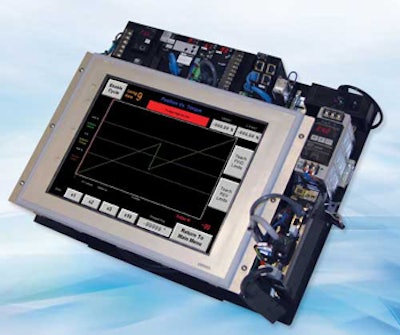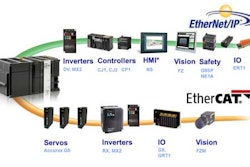Major automotive manufacturers want to take care of problems
before they happen. They would much rather figure out where there might
be a potential problem on the line and fix it during scheduled
downtime, rather than have it stop production. “It is very expensive
when a line goes down, even for just a few minutes” says Keith Grey,
strategic automotive account manager at Omron Industrial Automation.
“Scores of production workers are standing around getting paid to do
nothing, and product is not being produced.”
Considering all the common issues of downtime
in automotive plants, the ones that stand out as most problematic are
servo issues. Servo issues can take up to 45 minutes to fix; often they
are tricky to diagnose and address, and thus typically require specially
qualified personnel to resolve them. This is where Omron Industrial
Automation’s revolutionary new servo system comes into play. “We have
developed a servo system that combines a CJ2 programmable logic
controller, an NS-Series operator interface, and our newest EtherCAT
servo motor/drive to fix the problem,” says Grey.
Leveraging the speed of EtherCAT servo communications, the
new solution provides all the essential information of a servo system in
real time. This is displayed on the touchscreen to give the operator
feedback on everything that is going on within the servo system. Any
problem that can occur in the system can be displayed to show the
problem with a very detailed explanation on how to fix it.
For example, if a battery starts to fail, an alarm will come up
on screen that indicates the battery needs to be replaced. When the
operator touches this message, a pop-up screen displays a picture and
description of how to change the battery. But what if a more serious
problem arises, involving changing out a motor or drive? That type of
issue typically takes a very long time to resolve.
So Simple a Child Can Do It
The new solution has a preconfigured setup in the touchscreen that
shows a step-by-step procedure for replacing a motor and/or drive in a
few minutes. Pictures show the operator in clear detail exactly what
needs to be done. “Just for the heck of it, I had my 10-year old son,
who had never seen a servo in his life, fix a servo problem,” says Grey.
“It was a beautiful thing to watch.”
Everything a person needs to know is programmed into the system,
even for major issues such as changing out the motor or drive. It shows
the exact steps to take the motor out, how to disconnect the different
wires, and how to put them back in. Automatic resets have been provided
to zero the motor.
“I showed the system to a senior VP of a major automotive
manufacturer,” Grey continues. “We had them change out a motor and drive
right there, and they were able to do it in a few minutes. The VP said
he didn’t believe there was any way to do that, but seeing is believing.
Typically the process would take a long time and require the assistance
of an experienced hand.”
By providing real-time information for preventive action that
speeds response and simplifies corrective action when needed, this new
Omron Industrial Automation solution can be a significant contributor to
mitigating downtime risk for automotive manufacturers.
When the servo system is first installed, engineers can make the
machine go through its motion—its cycle—and then teach that cycle to
the system. The system stores the cycle in its PLC, which can be shown
graphically on the touchscreen.
The diagnostic process establishes the proper profile in two
seconds, then the system can be set to accept a plus/minus tolerance
range. If the machine goes plus or minus five percent from the good
profile, the system generates an output that lets the operator know.
Over time, mechanical parts (e.g., belts and chains) wear down.
Things get lodged in the machine that can interfere with its operation.
When these events occur, the system communicates the exact location of
the problem in the motion profile. It provides the manufacturer a
heads-up to adjust the machine proactively, before catastrophic failure
can cause production line downtime.
“I went into a Tier One supplier to the automotive manufacturers
and showed them this,” said Grey. “They said, ‘this is exactly what
we’ve been trying to do’.” According to Grey, the supplier was so
excited about the technology that they brought one of their machines to
an Omron Industrial Automation distributor to see how it worked on their
own equipment. Subsequently, they have placed an initial order for 10
of the systems. A full return on investment is expected within three
months of manufacturing.



























